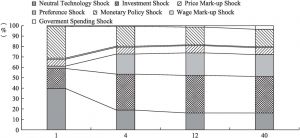论文
the Changes in Business Cycle and Driving Force Conversion in China
关键词
检索正文关键字
论文目录
- 1 Introduction
-
2 The New Keynesian DSGE Model
- 2.1 Final-Good Producers
- 2.2 Intermediate-Good Producers
- 2.3 Employment Agencies
- 2.4 Households
- 2.5 The Government and Market Clearing
- 2.6 The Full Model and External Shocks
-
3 Data and Parameter Estimation
- 3.1 Data Selection
- 3.2 Estimation Method
- 3.3 Parameter Calibration
-
4 Analysis on Driving Force Conversion in China’s Business Cycle
- 4.1 Analysis on Driving Force
- 4.2 Analysis on Business Cycle Conversion
- 4.3 Analysis on Driving Force Conversion
- 5 Conclusion
相关文献
the Changes in Business Cycle and Driving Force Conversion in China
Analysis of Nonlinear Dynamic Mechanism of Inflation and Phillips Curve
The Impact of Uncertainty on Japan’s Economy
Relationships Research among Control Mechanism, Cooperation and Suppliers Performance
查看更多>>>









